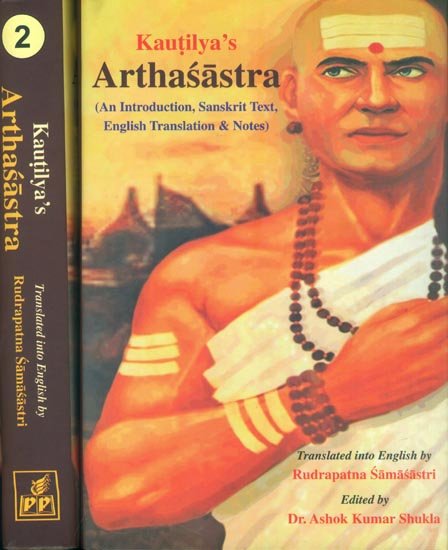Kautilya Arthashastra
by R. Shamasastry | 1956 | 174,809 words | ISBN-13: 9788171106417
The English translation of Arthashastra, which ascribes itself to the famous Brahman Kautilya (also named Vishnugupta and Chanakya) and dates from the period 321-296 B.C. The topics of the text include internal and foreign affairs, civil, military, commercial, fiscal, judicial, tables of weights, measures of length and divisions of time. Original ...
Chapter 2 - Division of Land
[Sanskrit text for this chapter is available]
The king shall make provision for pasture grounds on uncultivable tracts.
Brāhmans shall be provided with forests for sema plantation, for religious learning, and for the performance of penance, such forests being granted with safety for animate or inanimate objects, and being named after the tribal name (gotra) of the Brāhmans resident therein.
A forest as extensive as the above, provided with only one entrance, rendered inaccessible by the construction of ditches all round, with plantations of delicious fruit trees, bushes, bowers, and thornless trees, with an expansive lake of water, full of harmless animals, and with tigers (vyāla), beasts of prey (mārgāyuka), male and female elephants, young elephants, and bisons—all deprived of their claws and teeth—shall be formed for the king’s sports.
On the extreme limit of the country or in any other suitable locality, another game forest with game beasts, open to all, shall also be made. In view of procuring all kinds of forest produce described[1] elsewhere, one or several forests shall be specially reserved.
Manufactories to prepare commodities from forest produce and forests productive of commodities shall also be set up.
In the extreme limit of the country, elephant forests, separated from wild tracts, shall be formed.
The superintendent of elephant forests with his retinue of forest guards shall not only maintain the upkeep of the forests, but also [50] acquaint himself with all passages for entrance into, or exit from, such of them as are mountainous or boggy or contain rivers or lakes.
Whoever kills an elephant shall be put to death.
Whoever brings in the pair of tusks of an elephant, dead from natural causes, shall receive a reward of four-and-a-half paṇas.
Guards of elephant forests, assisted by those who rear elephants, those who enchain the legs of elephants, those who guard the boundaries, those who live in forests, as well as by those who nurse elephants, shall, with the help of five or seven female elephants to help in tethering wild ones, trace the whereabouts of herds of elephants by following the course of urine and dungs left by elephants and along forest tracts covered over with branches of Bhallātakī (Semicarpus Anacardium), and by observing the spots where elephants slept or sat before or left dungs, or where they had just destroyed the banks of rivers or lakes. They shall also precisely ascertain whether any mark is due to the movements of elephants in herds, of an elephant roaming single, of a stray elephant, of a leader of herds, of a tusker, of a rogue elephant, of an elephant in rut, of a young elephant, or of an elephant that has escaped from the cage.
Experts in catching elephants shall follow the instructions given to them by the elephant doctor (anīkastha), and catch such elephants as are possessed of auspicious characteristics and good character.
The victory of kings (in battles) depends mainly upon elephants; for elephants, being of large bodily frame, are capable not only to destroy the arrayed army of an enemy, his fortifications and encampments, but also to undertake works that are dangerous to life.
Elephants bred in countries, such as Kaliṅga, Aṅga, Karūśa, and the East are the best; those of the Daśārṇa and western countries are of middle quality; and those of Saurāṣṭra and Pañcajana countries are of low quality. The might and energy of all can, however, be improved by suitable training.
[Thus ends Chapter II, “Division of Land,” in Book II, “The Duties of Government Superintendents ” of the Arthaśāstra of Kauṭilya. End of twenty-third chapter from the beginning.]
Footnotes and references:
[1]:
See Chap. VII, Book II.
